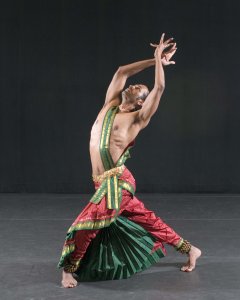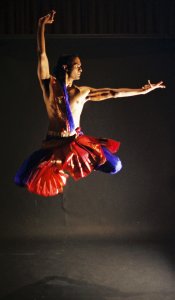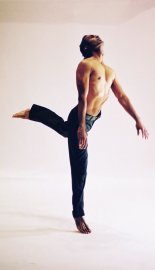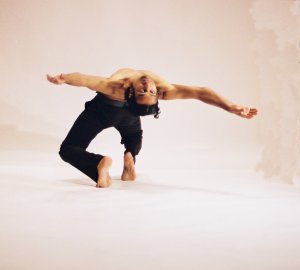 |
  |
 |
  |
The Phoenix rises in Washington DC - Krishna K Kasturi, Washington DC e-mail: indianarts2020@yahoo.com July 28, 2007 "In Cuba, I found a way in which dance was integral to the people's lives, it wasn't fractured from the other stuff that was happening," says Daniel, Artistic Director, Dakshina / Daniel Phoenix Singh & Company. It is this harmony that he brings to his audience, through his work and through his presentations. Daniel Phoenix Singh is also the director of Information Systems at the Association of American Colleges and Universities in DC, and if you were to run into him you would be charmed by his soft spoken demeanor without suspecting the dynamism that he packs in his lithe frame. He is an ideas man and one of the chosen few who can see their ideas through to reality. Daniel Phoenix Singh, true to his name, has suddenly become a household name in dance circles, in the span of just four years. Despite being a graduate in Dance from the University of Maryland, to accomplish such a feat is no mean task, especially in the Washington DC Metropolitan area where dance companies abound, especially in the field of Bharatanatyam, the classical Indian dance form which attracts the maximum number of students wishing to learn an Indian style. The Desi Diaspora has kept it alive but only within the precincts of the South Asian community, some have gone a little further and taken in non-Indian students, invited American friends and colleagues to their shows, received endowments and grants from local bodies but that is where the exchange ends. There is hardly any collaboration with the mainstream dance troupes, no attempt is made at understanding local issues and worse yet is the total indifference of the local media to a very vibrant and active scene right under their noses. Most of this attitude though stemming from ignorance also emphasizes how we as a community have failed to inculcate a more contemporary thought process in ourselves and our dancers. Lest we misunderstand 'contemporary' as something that is disrespectful of such an ancient art, being involved in social issues, dancing in tandem with Modern Ballet performers or collaborating with Gay groups is something that Bharata would be proud of. In the Natya Shastra, Bharata expounds how Dance is not a separate entity in itself but an amalgamation of various art forms from Poetry to Theatre and to let it stagnate in its own past is nothing short of abusing its sanctity. Using dance to evoke a sense of responsibility, a medium to confront our prejudices, all this takes great courage, and dancers of yore, from Balasaraswati to Rukmini Devi to the Tanjore Quartet made the necessary changes in posture or prayer according to their inner calling. They were ready to face the backlash of being called 'modern' but went right ahead! Margam today has become very elitist with the themes and stories revolving around a certain language or culture, those not in the know thus find it inaccessible to appreciate its beauty. Rasanubhuti is thus lost creating a disconnect between the performer and the rasika. Western Dance on the other hand, has given a lot to our own art form even if we do not acknowledge it, from stage décor to lighting to costume, group formations to multi media presentations to questioning the form itself. It has helped do away with the Sutradhar of the Indian dance for one. Something that is more modern and abstract has greater scope for imagery and the multiple meanings that can be evoked in the audience allows for a better appreciation of the art form.   Daniel strongly propagates learning other dance forms too, to understand how our body works; the different spatial patterns and rhythms of an alien dance will do wonders to present your body to you in a totally different light is what he promises. Especially how Modern dance frees up space, takes into consideration the aesthetics as well as the limitations of each body, working towards each body's comfort levels. Ardhamandali as we know it has been a root cause for many a back problem. Given the structure of classes nowadays both in India and abroad, where due to time constraints on the part of students and teachers, we have just one hour to go from start to finish, this comes as no surprise. No warm up or cooling down exercises leave the dancer in a very poor shape. Contrast this with a Ballet class where health is of top priority and all effort is made to teach the technique, not ram a fifty year old stance onto a five year old because it has been the norm to do it so. Natyarambha and various Adavus have changed and evolved over the years but it is unfortunate that no new adavu has been created in the past 100 years! When someone like Padma Subrahmanyam, Chandralekha, Swapnasundari or Daksha Sheth tries to steer away from this tradition of subservience, they are branded iconoclasts and brushed away. In all his collaborations too Daniel has shown an eclectic choice. From Pallabi Chakraborty for Kathak, local choreographer Eric Hampton to the Afro-Cuban dance Company AsheMoyubba. He has also assiduously worked to bring in big names from India to showcase his Fall presentations such as Mallika Sarabhai, the Dhananjayans, Ashwati Nair, Kishore Mosalikanti, Srikanth Natarajan. At the same time doing joint programs with DC based dance companies Kalanidhi and Nrityanjali. Dakshina has indeed become an offering of the ancient and the contemporary to the dance starved.   Not content with involving oneself only through dance, Daniel blends the personal and political by organizing Film Screenings, Dance Parties, Open Mikes. His Bhangra Nite which followed the first ever Indian dance performance at the National Geographic Society in 2005, drew huge crowds, eliciting interest from the Washington Post and the Voice of America. For the Spring Festival on March 31 and April 1, 2007, he featured Anna Sokolow's masterpiece KADDISH. She has been a key figure in developing modern dance, creating compositions that challenge audiences to think deeply about themselves and society. Daniel's WALK A WHILE WITH ME, exploiting Haiku to strip down movement to its bare essence also premiered in the festival. Joining them were the DC Cowboys Dance Company, a group of Gay dancers, a unique event for Washington. The upcoming Fall Festival on Oct 26, 27 and 28, 2007 with Malavika Sarukkai, Mallika Sarabhai and Hari Krishnan promises to be yet another grand showcase in his ever growing repertoire. Being Gay, he actively supports organizations that serve the South Asian LGBT community. Dakshina has performed at the DC Queer API Pride and Heritage celebration at Club Chaos in DC, a place he recommends to everyone and frequents for Salsa nights. It has been a tough ride he admits, first of all the difficulty in admitting, then having to face racism twice over, for being Brown AND Gay. Added to the fact that he is from a Christian family dancing to the tune of Hindu Gods, he could not have made it harder for himself! Ideally, Daniel dreams of taking his Company 'Dakshina' to Chennai. For all Indian dancers, Chennai is still the Mecca, especially during the Season. Also this is where he is from originally; he belongs to Chennai. Daniel envisages an exchange of ideas and lec-dems aimed at heightening understanding and broadening perspectives with local dancers/companies there. Having been witness to his growth since the inception of Dakshina in 2003, one has no doubt that this concept too will see to its fruition, very soon. Daniel is a student of Guru Meena Telikacherla, of the Kalakshetra and Pandanallur style. He has had the opportunity to work with Gurus Adyar Lakshman, C V Chandrasekhar and Bhanumathi. He is also a qualified Laban Movement Analyst from the Laban Institute of Movement Studies, NYC. Previous awards include among others: 1. Featured as one of the Dance Companies to watch by George Jackson in the National Dance Spirit magazine, Jan 2007. 2. Endowments from NEA and Creative Communities 3. Delegate in the Asia Society’s upcoming Asia 21 Young Leaders Summit, Nov 17-19 2006, Seoul, South Korea. Dakshina constitutes of 13 Board members and dancers who contribute in various capacities. He can be reached at www.dakshina.org An engineer by qualification and a writer by vocation, Krishna K Kasturi is currently a film maker who enjoys living in Hyderabad as well as in Washington DC. She is a Bharatanatyam dancer indulging in her love for dance by putting it down in writing. |